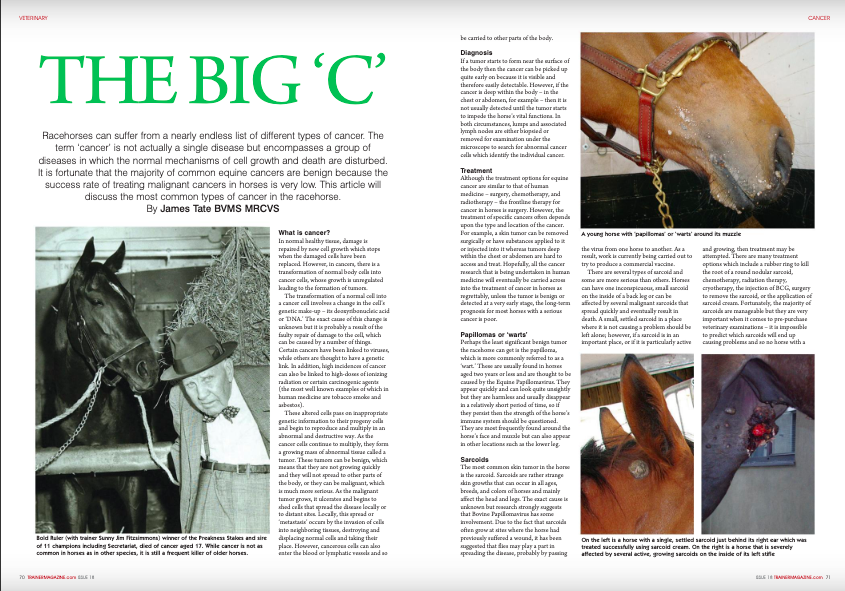Thermography
/CLICK ON IMAGE TO READ ARTICLE
Dr David Martin (February 1st 2012 - Issue 23)
CLICK ON IMAGE TO READ ARTICLE
Dr David Martin (February 1st 2012 - Issue 23)
CLICK ON IMAGE TO READ ARTICLE
Stacey Oke, DVM, MSc (February 1st 2012 - Issue 23)
North
American Trainer reader David Williams adds his thoughts to the article
on ‘The biomechanics of suspension’ that featured in our Breeders' Cup /
Winter 2011 issue.
David Williams (February 1st 2012 - Issue 23)
CLICK ON IMAGE TO READ ARTICLE
CLIVE WEBB-CARTER (February 1st 2012 - Issue 23)
CLICK ON IMAGE TO READ ARTICLE
REBECKA BLENNTOFT (18 October 2011 - Issue Number: Issue 22)
CLICK ON IMAGE TO READ ARTICLE
Dr. Jill Esz Smith DC (17 October 2011 - Issue Number: Issue 22)
CLICK ON IMAGE TO READ ARTICLE
Dr. Christine King (25 July 2011 - Issue Number: 21)
CLICK ON IMAGE TO READ ARTICLE
Sid Fernando (25 July 2011 - Issue 21)
CLICK ON IMAGE TO READ ARTICLE
Dr Colin Roberts BVSc MA PhD FRCVS (25 July 2011 - Issue 21)
CLICK ON IMAGE TO READ ARTICLE
Stacey Oke, DVM, MSc (25 July 2011 - Issue 21)

Is knowledge of the basic genetic make-up of a yearling the future? Genetic tests might be used to make decisions about which sire and dam to breed together. Once born, a genetic test may decide which foals should be sent to the sales and which to keep and race. As a trainer knowledge of a horse’s genetics might influence its training program and the direction of its racing career. Until recently, such genetic tests have not been available, but now this area of technology is changing fast.
By Dr David Marlin
First Published (20 April 2011 - Issue 20)

Stacey Oke, DVM, MSc discusses why a tiny, blood- loving, parasitic protozoan is making such a huge impact
on horses and the racing industry.
By Stacey Oke, DVM, MSc
First Published (20 April 2011 - Issue 20)

Electric starting gates were introduced to North American tracks in 1939 to avoid false starts and ensure a fair race. However, with their introduction came the increase of serious injury to the racehorse through both accidental contact with the stalls and the jump action.
By Samantha Ostridge
First Published (02 February 2011 - Issue Number: 19)

On Saturday, May 1, 2010, Super Saver, the 3-year-old colt bred and owned by WinStar Farm, LLC, won the Kentucky Derby by 2 1/2 lengths under the watchful eye of trainer Todd Pletcher. Three races later, on August 28, Super Saver finished tenth in the Travers, beaten by over 7 lengths. What happened to this talented colt in less than four months?
By Stacey Oke DVM MSc
First Published (2 February 2011 - Issue 19)

The old name for it is “broken wind,” we used to call it COPD (Chronic Obstructive Pulmonary Disease), we refer to it more commonly as “heaves,” and the most recent term that was adopted by vets and scientists who were studying it is Recurrent Airway Obstruction (RAO). Many of these terms are still in common use, and different groups of people involved with horses will possibly recognize the different terms for what is exactly the same condition.
By Dr David Marlin
First Published (20 October 2010 - Issue 18)

Racehorses can suffer from a nearly endless list of different types of cancer. The term ‘cancer’ is not actually a single disease but encompasses a group of diseases in which the normal mechanisms of cell growth and death are disturbed. It is fortunate that the majority of common equine cancers are benign because the success rate of treating malignant cancers in horses is very low. This article will discuss the most common types of cancer in the racehorse.
By James Tate BVMS MRCVS
First Published (20 October 2010 - Issue 18)

In a sport where everyone is looking for an edge, the latest for Thoroughbreds may be Kinesio tape. It is the same tape seen on tennis star Serena Williams, soccer player David Beckham, any number of University of Connecticut basketball players, and many others. It creates a lifting effect on the skin of humans and horses alike to improve circulation, relieve pain, and, depending on its application, relax or stimulate muscles.
By Ken Snyder
First Published (21 July 2010 - Issue Number: 17)

Tibial stress fractures are generally perceived to be serious injuries that occur infrequently and require lengthy recovery times. However, this article will suggest that these injuries are in fact much more common than most people think and are often misdiagnosed as pulled muscles. In addition, they may not be as serious as previously thought and with the help of sequential x-rays monitoring the injury, young horses can be returned to training surprisingly quickly.
By James Tate BVMS MRCVS
First Published (21 July 2010 - Issue 17)
Horse racing magazine for the training and development of the thoroughbred racehorse.